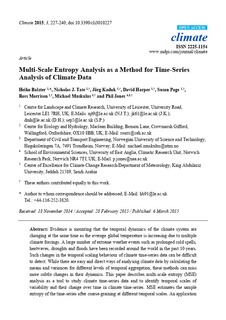| dc.contributor.author | Balzter, Heiko | |
| dc.contributor.author | Tate, Nicholas | |
| dc.contributor.author | Kaduk, Jörg | |
| dc.contributor.author | Harper, David | |
| dc.contributor.author | Page, Susan | |
| dc.contributor.author | Morrison, Ross | |
| dc.contributor.author | Muskulus, Michael | |
| dc.contributor.author | Jones, Phil Douglas | |
| dc.date.accessioned | 2019-11-13T10:01:15Z | |
| dc.date.available | 2019-11-13T10:01:15Z | |
| dc.date.created | 2015-03-06T21:19:39Z | |
| dc.date.issued | 2015 | |
| dc.identifier.citation | Climate. 2015, 3 (1), 227-240. | nb_NO |
| dc.identifier.issn | 2225-1154 | |
| dc.identifier.uri | http://hdl.handle.net/11250/2628102 | |
| dc.description.abstract | Evidence is mounting that the temporal dynamics of the climate system are changing at the same time as the average global temperature is increasing due to multiple climate forcings. A large number of extreme weather events such as prolonged cold spells, heatwaves, droughts and floods have been recorded around the world in the past 10 years. Such changes in the temporal scaling behaviour of climate time-series data can be difficult to detect. While there are easy and direct ways of analysing climate data by calculating the means and variances for different levels of temporal aggregation, these methods can miss more subtle changes in their dynamics. This paper describes multi-scale entropy (MSE) analysis as a tool to study climate time-series data and to identify temporal scales of variability and their change over time in climate time-series. MSE estimates the sample entropy of the time-series after coarse-graining at different temporal scales. An application of MSE to Central European, variance-adjusted, mean monthly air temperature anomalies (CRUTEM4v) is provided. The results show that the temporal scales of the current climate (1960–2014) are different from the long-term average (1850–1960). For temporal scale factors longer than 12 months, the sample entropy increased markedly compared to the long-term record. Such an increase can be explained by systems theory with greater complexity in the regional temperature data. From 1961 the patterns of monthly air temperatures are less regular at time-scales greater than 12 months than in the earlier time period. This finding suggests that, at these inter-annual time scales, the temperature variability has become less predictable than in the past. It is possible that climate system feedbacks are expressed in altered temporal scales of the European temperature time-series data. A comparison with the variance and Shannon entropy shows that MSE analysis can provide additional information on the statistical properties of climate time-series data that can go undetected using traditional methods. | nb_NO |
| dc.language.iso | eng | nb_NO |
| dc.publisher | MDPI | nb_NO |
| dc.rights | Navngivelse 4.0 Internasjonal | * |
| dc.rights | Navngivelse 4.0 Internasjonal | * |
| dc.rights.uri | http://creativecommons.org/licenses/by/4.0/deed.no | * |
| dc.rights.uri | http://creativecommons.org/licenses/by/4.0/deed.no | * |
| dc.title | Multi-Scale Entropy Analysis as a Method for Time-Series Analysis of Climate Data | nb_NO |
| dc.type | Journal article | nb_NO |
| dc.type | Peer reviewed | nb_NO |
| dc.description.version | publishedVersion | nb_NO |
| dc.source.pagenumber | 227-240 | nb_NO |
| dc.source.volume | 3 | nb_NO |
| dc.source.journal | Climate | nb_NO |
| dc.source.issue | 1 | nb_NO |
| dc.identifier.doi | 10.3390/cli3010227 | |
| dc.identifier.cristin | 1230120 | |
| dc.description.localcode | © 2015 by the authors; licensee MDPI, Basel, Switzerland. This article is an open access article distributed under the terms and conditions of the Creative Commons Attribution license (http://creativecommons.org/licenses/by/4.0/). | nb_NO |
| cristin.unitcode | 194,64,91,0 | |
| cristin.unitname | Institutt for bygg- og miljøteknikk | |
| cristin.ispublished | true | |
| cristin.fulltext | original | |
| cristin.qualitycode | 1 | |

